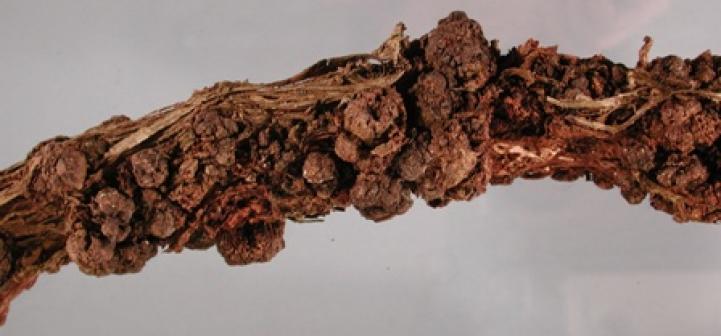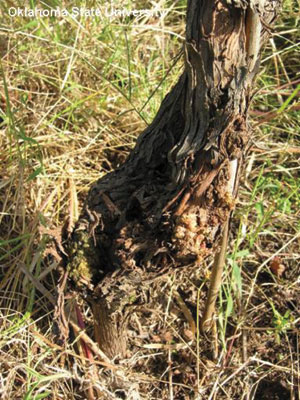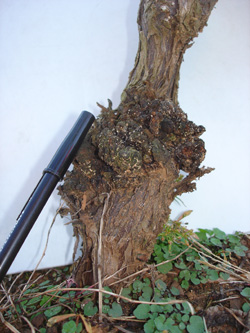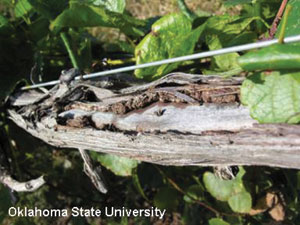
Symptoms Causes Management Options More Info
Damon Smith, Oklahoma State University
Symptoms
Figures 1 and 2. Crown gall symptoms on a one-year-old grape vine (L) and a somewhat fleshy gall symptom at a graft union of an older grape vine. Photos by Damon Smith, Oklahoma State University.
The most prevalent and identifiable symptom of Agrobacterium infection is the formation of galls. Galls typically form at points of injury or at graft unions near the soil surface (Figures 1 and 2). While many galls will form low on the vine near the soil surface, gall formation is possible on cordons or canes in the trellis (Figure 3). Infection by the bacterium results in the abnormal expansion and shape of the plants cells at or near the site of infection. Actively expanding galls will be comprised of white fleshy tissue (Figure 2). Older galls will become dry and cork-like, and, depending on the age, can become brittle and flaky (Figure 3). Bark cracking and peeling may also be associated with gall development (Figure 3). Gall symptoms can progress slowly and result in reduced vine vigor. Eventually, vine loss can occur due to girdling as a result of gall formation. In some cases, gall formation can be quite rapid, causing complete girdling and loss of the vine in a short period of time. Aerial root formation has also been associated with crown gall disease.
Causes
Grape crown gall is caused predominantly by the bacterium Agrobacterium vitis. However, A. tumefaciens (the predominant causal agent of crown gall of other crops) has also been isolated from galls on grape and is associated with the disease at a much lower frequency than A. vitis. Reports of grape crown gall have come from many parts of the world including China, Japan, South Africa, several European countries, the Middle East, and North and South America.
One of the most important characteristics of A. vitis is its ability to move and survive internally throughout the vine. Termed “systemic survival,” this feature allows the bacterium to take advantage of injuries induced by freeze damage or other wounding, and cause disease not only at the soil level, but also in the aerial parts of the plant canopy. In the spring, as sap begins to move into shoots from the roots, bacterial cells are transported throughout the plant. Bacteria can also be disseminated in apparently healthy cuttings. Vines can remain asymptomatic for several years until conditions are favorable for disease development to occur, such as wounding by freeze damage. Galls can also form at sites of disbudding, at the base of rooted cuttings, and at grafts. Galled vines will exhibit reduced vigor and yield. The bacterium can cause death (necrosis) of roots, and severe infections can kill entire vines.
If infected vines are removed from the vineyard, A. vitis can survive on roots or grape debris remaining in the soil for several years. As a result, eradication of the pathogen from an infested vineyard can be difficult. Research in Italy and New York has investigated A. vitis infestation in wild grape populations. In both studies, wild grape vines were not implicated in the maintenance of inoculum that resulted in the direct infection of commercial vineyards. Most inoculum originates from infested planting material or from soil containing infested grape debris.
While the infection process of A. vitis has not been studied in great detail, it is considered very similar to that of other Agrobacterium species such as A. tumefaciens, which causes crown gall on numerous plant species. Freezing and wounding are important in the infection process. Wounding not only provides a mode of entry (infection court) for the pathogen, but also results in the production of stress-induced compounds by the plant that attract the bacterial cells to those sites.
Planting Stock Management Options
Using cultivars resistant to crown gall is one of the best tools a grower can use to manage the disease in a vineyard. Susceptibility to A. vitis varies among grape cultivars. In general, Vitis vinifera cultivars are very susceptible to crown gall, while many American cultivars and French-American hybrids have some genetic resistance to the pathogen. Research has demonstrated that grafting of a susceptible scion to a resistant rootstock significantly reduces the incidence of crown gall under field conditions. While not well understood, the apparent resistance in the susceptible scion may be a result of reduced survival of A. vitis in the resistant rootstock or the production of compounds by the rootstock that are inhibitory to the bacterium. Shoot tip propagation has been used with some success to produce A. vitis-free planting material. Researchers have been unable to detect the bacterium in green shoots. In New York, vines propagated from green shoot-tip cuttings remained free of crown gall under cold climate conditions even after seven years of growth. This form of propagation may prove useful for producers looking to maintain their own high-quality disease free planting stock. An alternative is to purchase certified planting stock. While using certified stock is considered a good management practice, be aware that the certification only means that the bacterium was not detected and there is no complete guarantee that stock will be completely free of bacterial cells.
Cultural Management Options
Cultural practices that mitigate mechanical and freeze injury have proven most useful for managing this disease. Proper site selection is critical for new plantings. Avoid heavy soils in wet areas where frost is likely (low areas). Good sanitation practices when removing infected vines is critical. Take care to remove as much of the plant root system as possible. The crown gall pathogen can be present at high levels in the root system of infected plants. Removing and destroying as much of the plant debris as possible will reduce the ability of the pathogen to survive in the soil. The success of management strategies such as leaving soil fallow for extended periods or planting non-hosts to rid vineyards of the bacterium will have varying success depending on the level of infestation. Take care to limit soilborne nematode damage. Studies have shown that crown gall incidence was positively correlated with root-knot nematode damage. Growers should have soil in potential vineyard sites tested for root-knot nematode prior to planting. Avoid areas with infestations of root-knot nematode and choose nematode resistant rootstocks.
Chemical and Biological Management Options
While several chemical and biological control formulations are available for managing crown gall caused by A. tumefaciens in other crops, these formulations have proven ineffective in field trials for management of A. vitis-infected grape vines. No consistently reliable chemical or biological control methods have resulted in adequate control of A. vitis. However, research in the area of biological control is promising. Several antagonistic strains of A. vitis have been identified that do not produce galls and may have potential for use in the biological control of the grape crown gall pathogen. Their efficacy and commercial viability are currently under evaluation around the world.
Recommended Resources
Video: Crown Gall of Grape, University of Kentucky
Crown Gall of Grape, Pennsylvania State University
Grape Crown Gall, Cornell University
How Close are We to Crown Gall-Free Nursery Stock? Cornell University
Reviewed by Fritz Westover, Texas AgriLife Extension and Stephen Jordan, University of Wisconsin-Madison





